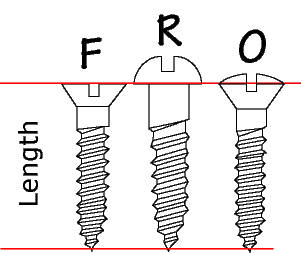
![]() Home > Products > Std Parts > Wood Screws
Home > Products > Std Parts > Wood Screws
Wood Screws Basics For pure holding power, screws are better than nails, screws are always used at wood joints. Common wood screws are made of steel or brass. The screw shank is threaded from the point up, about 2/3rds of its length. The upper third is smooth to the head. Flat head screws are used where the screw must be flush with the surface of the work. Round head screws protrude above the surface, making them easier to withdraw. Oval head screws combine features of flatheads and roundheads: they are partly countersunk in the work, and they protrude slightly above the surface. Most screw heads have either a single slot across the entire width or a recessed, X-shaped slot called a Phillips head.
Basically, a wood screw is described by its,
- Length;
- Gauge;
- Head style (Flat head, round head or oval head);
- Type of drive.
For many years American wood screws were made to two different standards, one a series that originated with the American Screw Co., and the other from the Asa I. Cook Co. In both series, sizes were indicated by gauge numbers, which went up to #30. (see historical table).
The overall dimensions in the two series were the same, but the number of threads differed slightly. When an American Standard for wood screws was adopted, most of the diameters were within a few thousandths of an inch of the old dimensions, but the sizes extended only to #24. For the current body diameters of the various gauges, see the pilot holes table.
IN SUM: Regarding the size, wood screws are designated by both length and diameter. Length is designated in inches. Diameter is designated by a gauge number. Lengths available run from ¼-in. to 6-ins. And are graduated by eighths of an inch to 1-in. Screws also vary in body diameter, expressed as a gauge number from 0 (about 1/16-in.) to 24 (about 3/8-in.). The label on the packing box of screws might read 1×6, meaning the box contains 1-inch screws of No.6 gauge. Most stores carry all standard lengths of screws in appropriate gauges. Most common gauges are No.2 through 16. The heavier the work required of the screws, the larger the gauge should be.
Usually Flat Countersunk Head, Oval Countersunk Head, Pan Head round or Round Head.
Note: In recognition of superior slot driving characteristics of pan head screws and the overlap in the dimensions of cross recessed pan heads and round heads, it is recommended that round heads be designated as nonpreferred and replaced by pan heads in new applications.
Usually slotted or Phillips,
but for a fuller discussion see screw drive systems.





